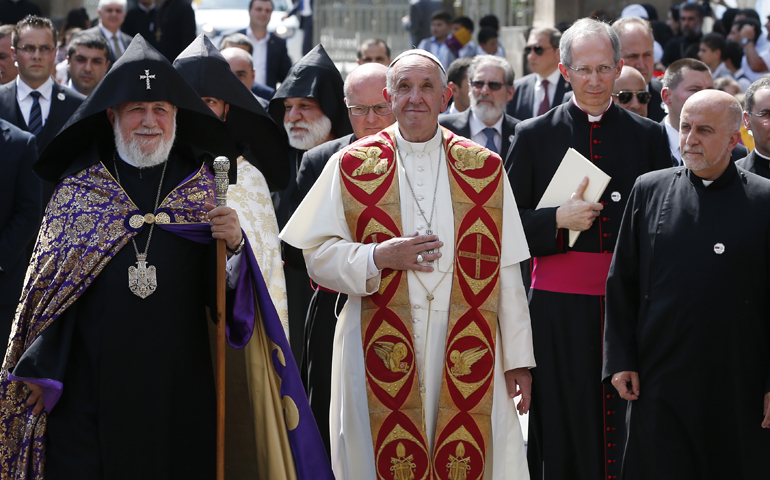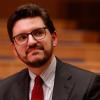
Catholicos Karekin II, patriarch of the Armenian Apostolic Church, and Pope Francis arrive to visit the Armenian Apostolic Cathedral at Etchmiadzin in Vagharshapat, Armenia, June 24. (CNS/Paul Haring)
Pope Francis risked causing a new rift between the Vatican and Turkey in the first of his visits during a three-day trip here by pointedly calling the World War I-era killings of some 1.5 million Armenians "genocide," a term Turkish leaders have staunchly rejected.
The pontiff used the word in a meeting with Armenian President Serzh Sargsyan Friday evening, adding it to prepared remarks that had carefully avoided the term.
As the prepared text indicated, Francis first referred to the killings by their Armenia description as the Metz Yeghérn, or the "Great Evil."
He then continued: "Sadly, that tragedy -- that genocide -- was the first of the deplorable series of catastrophes of the past century, made possible by twisted racial, ideological or religious aims that darkened the minds of the tormentors even to the point of planning the annihilation of entire peoples."
Much of the focus on Francis' Friday-Sunday trip to Armenia has centered on whether the pontiff would use the word genocide to describe the killings, which were carried out under the rule of the Ottoman Empire beginning in 1915.
Turkey, the successor state to the empire, claims that the word genocide does not accurately describe the killings. The pope caused a diplomatic kerfuffle with Turkish leaders in 2015 when he first used the term for the killings at a Mass held at the Vatican in commemoration of their centennial.
Turkey withdrew its ambassador to the Vatican for ten months following that event.
Besides Francis, both Sargsyan and the head of the Armenian Apostolic church, an Oriental Orthodox community which represents about 93 percent of the population of three million, referred strongly to the killings as a genocide in welcoming remarks upon the pope's landing here Friday.
Sargsyan and Catholicos Karekin II also both thanked the pope for hi s use of the word in 2015.
s use of the word in 2015.
Karekin said the Armenain people "remember with gratitude" that declaration, calling Francis' sermon for the earlier occasion historic.
Sargsyan said bluntly: "The message of justice is being conveyed to the mankind from the heart of the Catholic World heralding that the first of the mass atrocities having affected the humanity, the Armenian Genocide, is a historical fact and an undeniable reality."
"This was testified by the new wave of recognition of the Armenian genocide that followed the Mass celebrated by Pope Francis," the president continued.
The debate over the proper term for the historic killings evinces the difficult political situation Francis faces on his trip, the fourteenth he has taken outside Italy during his pontificate.
Armenia, a former Soviet republic in the Caucasus region, is located between the Black and Caspian Seas, with Turkey to its west and Azerbaijan to its east.
At the center of the papal visit stands a complex political relationship with Turkey. The two countries, both former members of the Ottoman Empire, do not have formal diplomatic relations and their shared border is closed with barbed-wire fencing.
Karekin spoke to Francis Friday on the first event during the Armenia trip, when the pope visited the cathedral of the apostolic church. Sargsyan spoke at a second meeting later at the presidential palace with the country's political leaders.
At that event, Francis mentioned his 2015 Mass and said the 1915 killings included "a vast multitude of persons."
"Having seen the pernicious effects to which hatred, prejudice and the untrammelled desire for dominion led in the last century, I express my lively hope that humanity will learn from those tragic experiences the need to act with responsibility and wisdom to avoid the danger of a return to such horrors," he continued.
The pope also said it was "vitally important" for all believers to "join forces to isolate those who use religion to promote war, oppression and violent persecution, exploiting and manipulating the holy name of God."
He especially called on Armenians to use their experience to empathize with Christians facing violence and persecution today.
"The Armenian people have experienced these situations firsthand; they have known suffering and pain; they have known persecution; they preserved not only the memory of past hurts, but also the spirit that has enabled them always to start over again," said Francis.
"I encourage you not to fail to make your own precious contribution to the international community," he continued.
At the earlier meeting with the Orthodox community, the pontiff said that the world is "marked by divisions and conflicts" and expects Christians of different churches to give a "witness of mutual esteem and fraternal cooperation capable of revealing to every conscience the power and truth of Christ’s resurrection."
"The spirit of ecumenism takes on an exemplary value also outside of the visible confines of the ecclesial community," said the pope. "It represents for everyone a forceful appeal to settle divergences with dialogue and appreciation for all that unites us."
"We offer to the world -- which so urgently needs it -- a convincing witness that Christ is alive and at work, capable of opening new paths of reconciliation among the nations, civilizations and religions," he continued. "We offer a credible witness that God is love and mercy."
Francis landed Friday in Yerevan, the Armenian capital, to small crowds of schoolchildren greeting him with signs and chants. The children were wearing white while holding small Vatican flags and signs welcoming the pope written in Spanish.
The streets leading to the city center were lined with banners and signs with the Vatican's coat of arms and the coat of arms of the Armenian apostolic church. Along the way were also several monuments to the 1915 killings, including one banner showing what it called the "tools of massacre:" a noose, an axe, and other instruments to kill.
Francis is to visit Yerevan's memorial museum to the killings Saturday morning before heading about 75 miles northwest to Armenia's second largest city, Gyumri. Once there he will celebrate a Mass and visit the city's Armenian Apostolic and Catholic cathedrals before heading back to Yerevan.
On Sunday, the pontiff is to participate in an Orthodox liturgy led by Karekin and make a visit to the Orthodox monastery of Khor Virap. He returns to Rome Sunday evening.
[Joshua J. McElwee is NCR Vatican correspondent. His email address is jmcelwee@ncronline.org. Follow him on Twitter: @joshjmac.]




